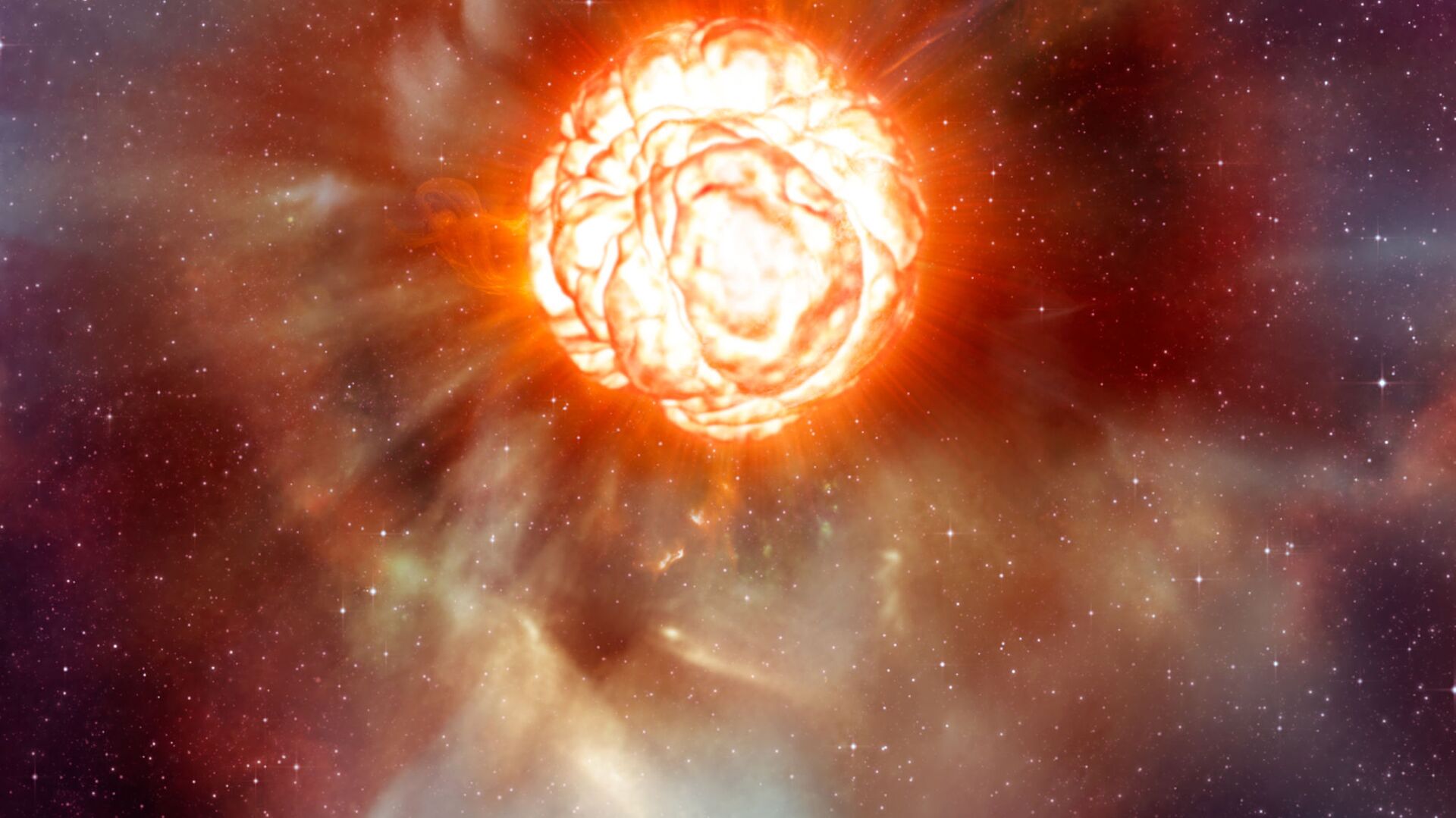Betelgeuse's 'Great Dimming' Likely Triggered by Dark Star-Spot That Made Temperatures Plummet

CC BY 4.0 / ESO/L. Calçada / A plume on Betelgeuse (artist’s impression)
Subscribe
Sitting in the constellation of Orion, the 10th brightest star in the sky Betelgeuse is a supergiant, likely to explode at the end of its life cycle in 100,000 years. However, it displayed an unexpected dimming, and by April 2020 dropped to 40 percent of its usual luminosity, triggering speculation it might go supernova.
Betelgeuse, the bright star located in the shoulder of the Orion constellation and visible to the naked eye, experienced a massive dip in brightness likely due to a dark star-spot that caused a drop in surface temperature, a new study claims.
Although the bright reddish star is a variable, noted for fluctuating brightness, from October 2019 to March 2020 had fallen to 60%. of its luminosity. This most significant observed drop in 50 years left astronomers puzzling over the irregular light change.
After Betelgeuse began to brighten again from April 2020, a supernova was ruled out, and astronomers set out to find a new theory to explain the unusual event.
A plethora of studies put forward various theories to explain the phenomenon, dubbed the Great Dimming, reported by the European Southern Observatory’s (ESO) Very Large Telescope (VLT) and Ultraviolet observations by the Hubble Space Telescope.
Hubble observations show that the unexpected dimming of supergiant star #Betelgeuse was probably caused by an immense amount of hot plasma ejected into space. The plasma cooled, forming a dust cloud that blocked starlight coming from Betelgeuse’s surface: https://t.co/PwFEGo4Nvx pic.twitter.com/GuTOrop7me
— Hubble Space Telescope (@HubbleTelescope) August 13, 2020
They ranged from pre-phase of a supernova explosion (at the end of the life cycle of a red supergiant) to a giant cloud of dust and gas moving between the Earth and Betelgeuse, and changes in the photosphere of the star.
Here we go after so many months of controlled patience, our article revealing what happened to #Betelgeuse is finally online at @Nature : https://t.co/We2xIa5BBP (1/6) pic.twitter.com/s15xViaR1F
— Dr. Miguel Montargès 🔭⭐📡 💉💉 (@Astro_MiguelM) June 16, 2021
I strongly advise anyone interested in this event to take a look at @ESO's press release with really great content revealing what we saw.
— Dr. Miguel Montargès 🔭⭐📡 💉💉 (@Astro_MiguelM) June 16, 2021
Video: https://t.co/9kToh1VnQm
Press release : https://t.co/lhtSdOdYpX (2/6)
Research published on June 16, 2021in Nature claimed the mysterious dimming was caused by a dusty veil shading the star.
Mysterious Temperature Drop
Now a new study led by Prof. ZHAO Gang from the National Astronomical Observatories of the Chinese Academy of Sciences (NAOC) sheds fresh light on the nature of the mysterious dimming.
The research, that involved scientists from Shandong University and the University of Missouri (USA), laid out its findings in Nature Communications on 5 August 2021.
The team investigated the high-resolution near-infrared spectra of Betelgeuse obtained at Weihai Observatory of Shandong University on 31 January, 19 March, 4 April, and 6 April 2020. This period covered the dimming and post-dimming phases. Betelgeuse is the brightest star in the night sky in the near-infrared wavelength range.
“Taking our advantage in spectroscopic analysis, we aim to understand the possible cause of the mysterious dimming of Betelgeuse,” Prof. ZHAO Gang was cited by media outlets reporting on the study as saying.
For their research, the team developed a special technique to determine the effective temperatures of red supergiants, looking for specific chemicals in its atmosphere.
“Our method is based on the measurement of titanium oxide (TiO) and cyanide (CN) molecular lines in stellar spectra. The cooler a star is, the more these molecules can form and survive in its atmosphere and the molecular lines are stronger in the stellar spectrum. In a hotter atmosphere, these molecules dissociate easily and do not survive,” said Dr. Sofya Alexeeva, the first author of this study.
The team discovered that at the minimum of its luminosity, the effective temperature of Betelgeuse on 31 January 2020, was 3476 Kelvins. However, on 6 April after recovering its brightness, the temperature was 3646 Kelvins. The lowering temperature reduced the star’s overall luminosity, making it appear less bright during the time of dimming.
It was suggested that such a temperature drop might have been triggered by a large dark star-spot on the surface of Betelgeuse. Red supergiants are noted for displaying this phenomenon. Convective flows or cool convective cells, which are widely believed to be present in such stars, could generate such dark spots.
“Our findings offer insight in to the nature of red supergiant stars, the main contributors to the enrichment of heavy elements in the Universe,” said Prof. ZHAO Gang.

